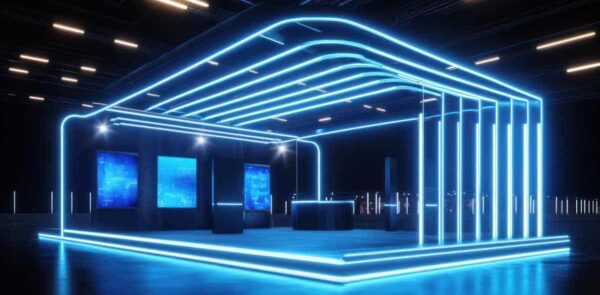
Jump to a section:
Trade shows can serve as gold mines for market research firms, offering an unparalleled opportunity to connect with potential clients, showcase analytical expertise, and establish thought leadership in a competitive industry. While many businesses attend trade shows to boost brand visibility and discover new leads, market research firms have an additional layer of interest: networking with decision-makers who value data-driven insights. The challenge lies in creating a trade show booth that not only attracts foot traffic but also helps your firm stand out in a sea of cutting-edge technology providers, consultants, and research agencies.
In this Event Engagement Playbook, we’ll guide you through every step of trade show booth design—focusing on brand communication, interactivity, lead generation, and post-event follow-up. By the time you’ve finished reading, you’ll have a clearer blueprint on how to turn your booth into a hub of engagement that resonates with attendees and sets your market research firm apart from the crowd.
Clarifying Your Objectives and Target Audience
Setting Clear Goals
Before you even consider your booth’s design aesthetic, it’s crucial to define your objectives. Are you aiming to generate high-quality leads? Do you want to introduce a new research methodology or technology platform? Are you primarily looking to reinforce your brand identity? By clarifying these goals, you can tailor your booth layout, messaging, and interactive elements more effectively.
Identifying Who Matters Most
Market research firms often have multiple buyer personas—marketing executives, product managers, and sometimes even small business owners seeking consumer insights. Each group has its own language, priorities, and concerns. For instance, a marketing executive might be drawn to a cost-effective consumer segmentation method, while a product manager might be more interested in usability testing protocols. Knowing your audience makes it easier to create targeted signage, handouts, and interactive demos that speak directly to each segment’s unique pain points.
Stats to Support the Importance of Planning
- According to the Center for Exhibition Industry Research (CEIR), 81% of trade show attendees have buying authority, indicating that key decision-makers are highly represented at these events.
- A 2022 trade show marketing survey reported that companies with clear, documented objectives achieved up to 35% higher lead conversion rates post-event than those without a structured plan.
Booth Layout and Visual Branding
Open Spaces vs. Closed Concepts
When designing your booth, consider how you’ll physically interact with attendees. Open-concept layouts (where there are minimal barriers between your booth and the aisles) often encourage more people to step inside and engage. However, if you need a private discussion area to go over sensitive or proprietary data, a partially enclosed section might be beneficial.
Brand Consistency
For a market research firm, your booth is a canvas that communicates your expertise. Incorporate brand colors, logos, and compelling taglines that highlight your services. Use a crisp, modern design to convey that your firm is forward-thinking and data-savvy. You might use large, data-driven graphics or charts that give a quick snapshot of your capabilities—something like “We Helped 50+ Fortune 500 Companies Increase Market Share Through Our Insights” or “Data Solutions Trusted by 80% of Top Tech Companies.” These statements should be bold and visible from afar, instantly letting attendees know who you are and what you do.
Tech-Enabled Displays
Modern LED screens and interactive tablets can showcase infographics or short videos explaining complex data analytics in layman’s terms. You can also display real-time sampling of your firm’s capabilities—like a mini dashboard where visitors can see how your data visualization tools work. According to a 2023 expo technology survey, 68% of attendees are more likely to recall brands that utilize interactive digital displays than those that rely solely on static banners.
Pro Tip: If you’re running on a budget, you don’t need a massive video wall. Even one large TV with well-designed slides or animations can make a big impact, especially if combined with friendly staff ready to explain the visuals.
Showcasing Expertise Through Interactive Experiences
Hands-On Demonstrations
One of the most effective ways to stand out at a trade show is by letting people experience your services firsthand. For example, if your firm specializes in consumer behavior analysis, consider creating a short, fun quiz that profiles a person’s shopping preferences. You could demonstrate how your algorithm categorizes consumer behavior in real-time. This tangible, interactive element helps you forge an immediate connection because attendees gain something personal and memorable—insight into their own consumer habits.
Live Workshops or Presentations
If the trade show allows for presentations or short breakout sessions, use that platform to discuss a hot industry trend like AI-driven predictive analytics or advanced segmentation techniques. You could host a 20-minute workshop titled “How to Leverage Big Data for Real-Time Market Decisions,” giving attendees practical tips. These sessions position you as a thought leader and significantly boost traffic to your booth afterward.
Stat Spotlight: Research from the Trade Show News Network (TSNN) shows that booths with interactive activities can see up to 30% more foot traffic than those without. Additionally, 45% of attendees stated they remembered brands better when they experienced a hands-on demonstration.
Gamification
Adding a gamification element—like a spin-the-wheel or trivia quiz with small prizes—can keep people at your booth longer. While it’s essential to remain professional, especially for a market research firm, there’s still a place for fun. For instance, you can quiz attendees on market trends or surprising consumer insights. This not only entertains but also educates them about your expertise. A small digital leaderboard can spur friendly competition and encourage more people to participate.
Staff Training and Engagement
Selecting the Right Team
Who you choose to represent your firm at the booth can make or break your event experience. Ideally, pick a mix of people with strong communication skills, deep product knowledge, and a knack for quick thinking. Market research topics can get technical, so having an analyst or project manager available to answer in-depth questions can be a significant advantage.
Training and Role-Playing
Before the event, rehearse potential scenarios. Train staff to ask open-ended questions that draw out a visitor’s pain points. For instance, they could ask: “How are you currently gathering consumer insights?” or “What challenges have you faced in turning data into actionable strategies?” This approach can uncover valuable information, allowing you to demonstrate exactly how your services fit into their needs.
Engagement Tips
- Personalized Greetings: A warm smile and direct eye contact set a welcoming tone.
- Listening Skills: Let attendees explain their problems or questions fully before jumping in with a pitch.
- Clear Explanations: When discussing complex data methodologies, break them down into simple analogies.
- Follow-Up Strategies: Encourage staff to collect business cards or scan badges and note specific conversation details to reference later.
Stat to Remember: A 2020 staffing and engagement report found that trained, enthusiastic booth staff can increase lead capture by up to 25% compared to untrained teams.
Lead Capture and Post-Event Follow-Up
Digital Lead Capture Tools
Gone are the days of merely collecting business cards in a fishbowl. Today, specialized lead capture apps let you scan a badge or take a quick photo of a business card, automatically populating a CRM system with contact info and relevant notes. This digital approach dramatically reduces the chance of losing leads and allows for easier segmentation once the event is over. When you can instantly tag a contact with their primary interest—such as “focus group services” or “behavioral analytics”—your post-event marketing becomes far more targeted.
Segmentation for Focused Messaging
Your booth is likely to attract a wide variety of prospects. Segmenting them ensures that your follow-up messages are relevant and compelling. For example:
- Hot Leads – People who expressed immediate interest or have a clear budget for research services.
- Warm Leads – Attendees who seemed curious but might still be exploring options.
- Industry Peers / Partners – Potential partners, vendors, or organizations that you could collaborate with.
Within 48 hours of the event, consider sending a personalized email or LinkedIn message referencing the specific conversation or demo they saw. Add value by sharing additional resources or blog posts that align with their interests.
Nurturing the Relationship
Market research services aren’t an impulse buy; they often require stakeholder approvals and budget allocations. This means a longer sales cycle. Follow-up should be steady but unobtrusive. Provide case studies, whitepapers, or a short webinar invitation to demonstrate how your data insights have driven significant ROI for clients. According to a 2021 study by the Aberdeen Group, companies that excel at lead nurturing generate 50% more sales-ready leads at a 33% lower cost.
Measuring Success and Looking Ahead
Key Performance Indicators (KPIs)
To gauge the success of your trade show participation, track metrics such as:
- Number of Qualified Leads Generated
- Booth Traffic and Engagement Time
- Social Media Mentions/Hashtags
- Scheduled Follow-Up Meetings
- Deals Closed Directly Attributable to the Event
For market research firms, another crucial KPI could be the number of partnership inquiries, especially from complementary businesses like advertising agencies or tech platforms.
ROI Calculation
Compare the total cost of attending (booth fees, travel, materials, staffing) to the opportunities generated from the event. Keep in mind that results from market research services might take months to materialize. A multi-touch attribution model can help you identify whether initial conversations from the trade show led to final contracts.
Long-Term Strategy
Trade shows can be more than one-off events; they’re building blocks for long-term brand recognition. Keep in contact with your leads and consistently share thought leadership materials. This approach ensures that, even if they don’t need your services immediately, they’ll think of you when the need does arise. A 2022 B2B marketing report noted that consistent follow-up and branding efforts increased brand recall by 80%, leading to higher win rates over time.
Conclusion
Designing an engaging trade show booth for a market research firm involves a strategic balance of visual appeal, informative content, and meaningful interactions. By clarifying your objectives, targeting the right audience, and offering hands-on demonstrations, you’ll create memorable experiences that reinforce your firm’s credibility. Don’t underestimate the power of well-trained booth staff and a robust lead follow-up plan—these elements often make the difference between a forgettable booth and one that resonates well after the event ends.
Armed with this Event Engagement Playbook, you’re ready to stand out at your next trade show. Your booth isn’t just a physical space; it’s an opportunity to spark conversations, demonstrate expertise, and cultivate relationships that can fuel your firm’s growth for years to come. Best of luck in making your booth the centerpiece of the show floor and setting the stage for new partnerships and business opportunities.
